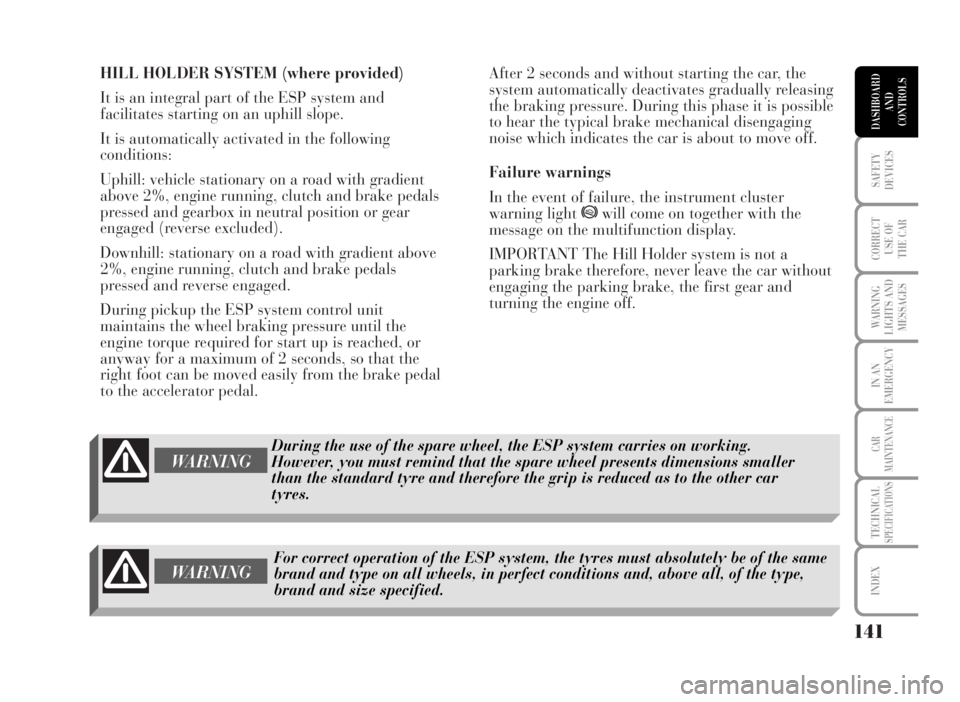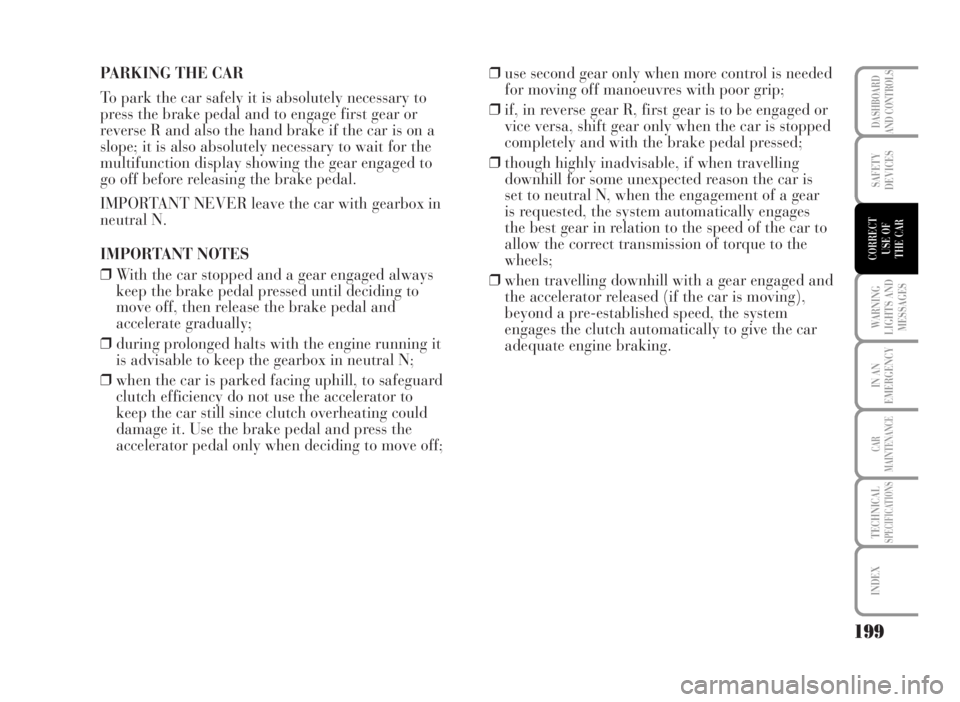torque Lancia Musa 2007 Owner handbook (in English)
[x] Cancel search | Manufacturer: LANCIA, Model Year: 2007, Model line: Musa, Model: Lancia Musa 2007Pages: 346, PDF Size: 5.15 MB
Page 142 of 346

HILL HOLDER SYSTEM (where provided)
It is an integral part of the ESP system and
facilitates starting on an uphill slope.
It is automatically activated in the following
conditions:
Uphill: vehicle stationary on a road with gradient
above 2%, engine running, clutch and brake pedals
pressed and gearbox in neutral position or gear
engaged (reverse excluded).
Downhill: stationary on a road with gradient above
2%, engine running, clutch and brake pedals
pressed and reverse engaged.
During pickup the ESP system control unit
maintains the wheel braking pressure until the
engine torque required for start up is reached, or
anyway for a maximum of 2 seconds, so that the
right foot can be moved easily from the brake pedal
to the accelerator pedal.After 2 seconds and without starting the car, the
system automatically deactivates gradually releasing
the braking pressure. During this phase it is possible
to hear the typical brake mechanical disengaging
noise which indicates the car is about to move off.
Failure warnings
In the event of failure, the instrument cluster
warning light
*will come on together with the
message on the multifunction display.
IMPORTANT The Hill Holder system is not a
parking brake therefore, never leave the car without
engaging the parking brake, the first gear and
turning the engine off.
141
SAFETY
DEVICES
CORRECT
USE OF
THE CAR
WARNING
LIGHTS AND
MESSAGES
IN AN
EMERGENCY
CAR
MAINTENANCE
TECHNICALSPECIFICATIONS
INDEX
DASHBOARD
AND
CONTROLS
WARNING
During the use of the spare wheel, the ESP system carries on working.
However, you must remind that the spare wheel presents dimensions smaller
than the standard tyre and therefore the grip is reduced as to the other car
tyres.
WARNING
For correct operation of the ESP system, the tyres must absolutely be of the same
brand and type on all wheels, in perfect conditions and, above all, of the type,
brand and size specified.
Page 196 of 346

Automatic operation (AUTO - ECO)
The ECO function can be activated only with automatic mode active.
To activate the ECO function press button E set on the mask near the
gearshift lever. After activating this function, the display shows the
gear engaged and words AUTO and E (see figure).
With ECO function active the system will select the most suitable gear
(according to car speed, engine rpm and how the accelerator pedal is
pressed) to save as much fuel as possible.
If necessary (e.g.: overtaking) the system will change gears in order
to provide suitable torque and power for acceleration (this will take
place in automatic mode regardless of ECO function condition, ON or
OFF).
195
WARNING
LIGHTS AND
MESSAGES
IN AN
EMERGENCY
CAR
MAINTENANCE
TECHNICALSPECIFICATIONS
INDEX
DASHBOARD
AND CONTROLS
SAFETY
DEVICES
CORRECT
USE OF
THE CAR
L0D1244g
L0D0334m
Page 200 of 346

PARKING THE CAR
To park the car safely it is absolutely necessary to
press the brake pedal and to engage first gear or
reverse R and also the hand brake if the car is on a
slope; it is also absolutely necessary to wait for the
multifunction display showing the gear engaged to
go off before releasing the brake pedal.
IMPORTANT NEVER leave the car with gearbox in
neutral N.
IMPORTANT NOTES
❒With the car stopped and a gear engaged always
keep the brake pedal pressed until deciding to
move off, then release the brake pedal and
accelerate gradually;
❒during prolonged halts with the engine running it
is advisable to keep the gearbox in neutral N;
❒when the car is parked facing uphill, to safeguard
clutch efficiency do not use the accelerator to
keep the car still since clutch overheating could
damage it. Use the brake pedal and press the
accelerator pedal only when deciding to move off;❒use second gear only when more control is needed
for moving off manoeuvres with poor grip;
❒if, in reverse gear R, first gear is to be engaged or
vice versa, shift gear only when the car is stopped
completely and with the brake pedal pressed;
❒though highly inadvisable, if when travelling
downhill for some unexpected reason the car is
set to neutral N, when the engagement of a gear
is requested, the system automatically engages
the best gear in relation to the speed of the car to
allow the correct transmission of torque to the
wheels;
❒when travelling downhill with a gear engaged and
the accelerator released (if the car is moving),
beyond a pre-established speed, the system
engages the clutch automatically to give the car
adequate engine braking.
199
WARNING
LIGHTS AND
MESSAGES
IN AN
EMERGENCY
CAR
MAINTENANCE
TECHNICALSPECIFICATIONS
INDEX
DASHBOARD
AND CONTROLS
SAFETY
DEVICES
CORRECT
USE OF
THE CAR
Page 203 of 346

DRIVING STYLE
Starting
Do not warm the engine with the car at a standstill
or at idle or high speed: under these conditions the
engine warms up much more slowly, increasing
electrical consumption and emissions. It is therefore
advisable to move off immediately, slowly, avoiding
high speeds. This way the engine will warm faster.
Unnecessary actions
Avoid accelerating when waiting at traffic lights or
before switching off the engine. This and also
double declutching is absolutely pointless on
modern cars and also increase consumption and
pollution.
Gear selection
As soon as the conditions of the traffic and road
allow, use a higher gear. Using a low gear to obtain
brilliant performance increases consumption.
In the same way improper use of a high gear
increases consumption, emissions an engine wear.
Top speed
Fuel consumption considerably increases with
speed. Keep speed as constant as possible, avoid
superfluous braking and accelerating, which cost in
terms of both fuel and emissions. Acceleration
Accelerating violently increasing the revs will
greatly affect consumption and emissions:
acceleration should be gradual and should not
exceed the maximum torque.
CONDITIONS OF USE
Cold starting
Short journeys and frequent cold starts do not allow
the engine to reach optimum operating temperature.
This results in a significant increase in consumption
levels (from +15 to +30% on the urban cycle) and
emission of harmful substances.
Traffic situations and road conditions
Rather high consumption levels are tied to
situations with heavy traffic, for example in queues
with frequent use of the lower gears or in cities with
many traffic lights. Also winding mountain roads
and rough road surfaces adversely affect
consumption.
Traffic hold-ups
During prolonged hold-ups (e.g.: level crossings) the
engine should be switched off.
202
WARNING
LIGHTS AND
MESSAGES
IN AN
EMERGENCY
CAR
MAINTENANCE
TECHNICALSPECIFICATIONS
INDEX
DASHBOARD
AND CONTROLS
SAFETY
DEVICES
CORRECT
USE OF
THE CAR
Page 323 of 346

322
WARNING
LIGHTS AND
MESSAGES
INDEX
DASHBOARDAND CONTROLS
SAFETY
DEVICES
CORRECT
USE OF
THE CAR
IN AN
EMERGENCY
CAR
MAINTENANCE
TECHNICALSPECIFICATIONS
1.3 Multijet 70HP
188A9000
Diesel
4 in line
4
69.6 x 82
1248
18±0.4
51
70
4000
180
18.3
1750
–
Unleaded petrol
95 RON (EN228
Specifications)1.3 Multijet 90HP
199A3000
Diesel
4 in line
4
69.6 x 82
1248
17.6±0.4
66
90
4000
200
20
1750
–
Diesel fuel for
motor vehicles
(EN590
Specifications)1.9 Multijet
188B2000
Diesel
4 in line
2
82 x 90.4
1910
18±1
74
100
4000
260
26.4
2000
–
Diesel fuel for
motor vehicles
(EN590
Specifications) 1.4
8V◊)
350A1000
Otto
4 in line
2
72 x 84
1368
11±0.2
57
77
6000
115
11.7
3000
NGK ZKR7A-10
Unleaded petrol
95 RON (EN228
Specifications)1.4
16V
843A1000
Otto
4 in line
4
72 x 84
1368
11±0.2
70
95
5800
128
13
4500
NGK ZKR7A-10
Unleaded petrol
95 RON (EN228
Specifications)
ENGINE
GENERAL FEATURES
Engine code
Cycle
Number and layout of cylinders
Valves per cylinder
Piston bore and stroke mm
Total displacement cm3
Compression ratio
Maximum power (EEC) kW
HP
corresponding ratio: rpm
Maximum torque (EEC) Nm
kgm
corresponding ratio: rpm
Spark plugs
Fuel
◊) Engine model provided for certain versions/markets only